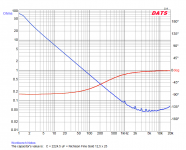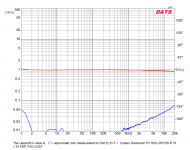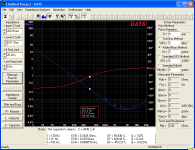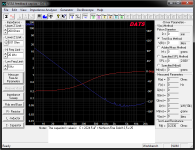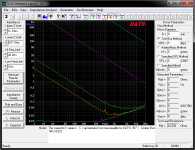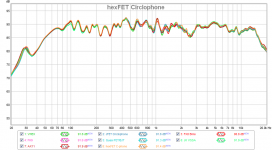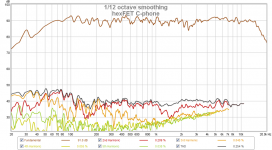Hi X will have to listen to your sound clip sharings one of these days when time allow and maybe have a drink as other members did : ) thanks the hard work.
Regarding your own comment for VSSA in below plot: "appears to have a little more bite in the higher registers - some would call "highly resolving"?
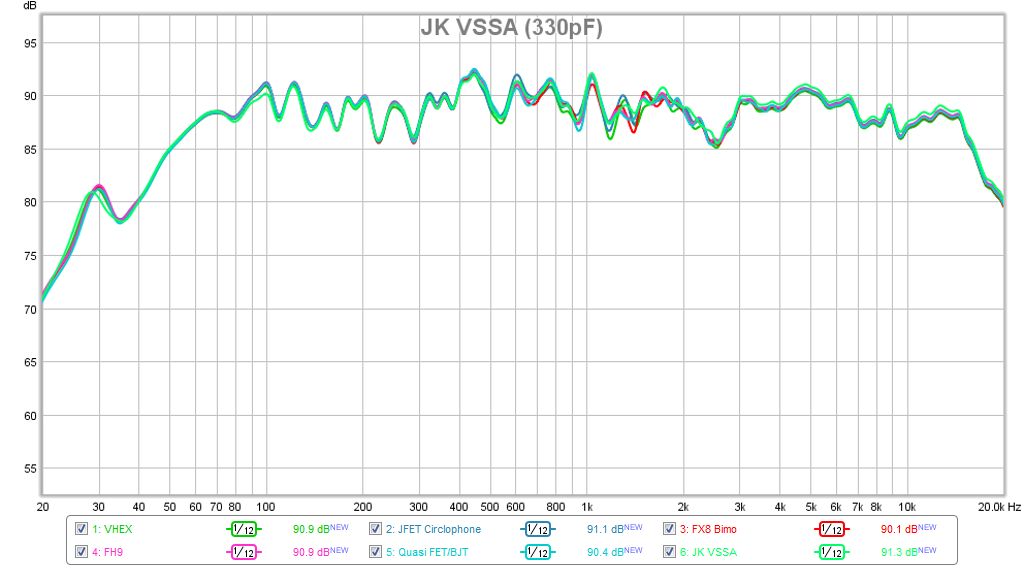
Think because above lift is over wide range it should be very audio able, also have a VSSA variant myself and think its feedback capacitor setup have enormous influence on percieved sound. That feedback capacitor is supposed to be AC linear from DC or few Hz to lightspeed but it isn't, below DATS plot is 2,2mF nichicon FG and funny to see how its lowest impedance peak seems in sync with the lift in your plot, so maybe if a clever network of resistors and capacitors with linear AC impedance would improve audio performance for the various VSSA variants. In second DATS plot is shown impedance of a low voltage huge value 35F Cooper Bussmann super capacitor that maybe combined in a network could help what Jay miss in below notes.
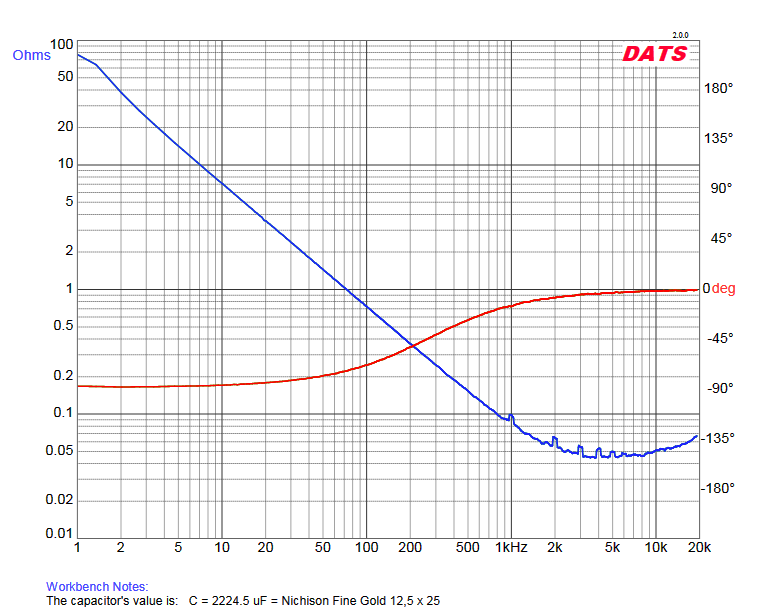
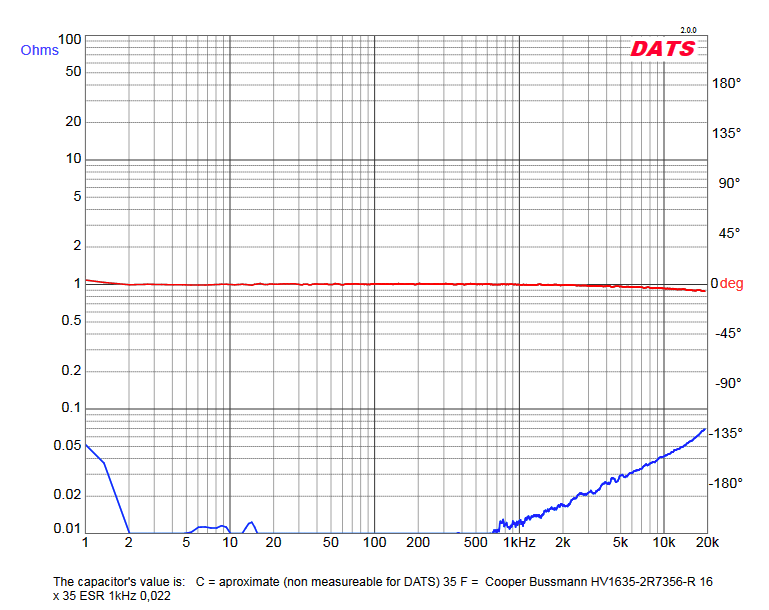
Regarding your own comment for VSSA in below plot: "appears to have a little more bite in the higher registers - some would call "highly resolving"?

Think because above lift is over wide range it should be very audio able, also have a VSSA variant myself and think its feedback capacitor setup have enormous influence on percieved sound. That feedback capacitor is supposed to be AC linear from DC or few Hz to lightspeed but it isn't, below DATS plot is 2,2mF nichicon FG and funny to see how its lowest impedance peak seems in sync with the lift in your plot, so maybe if a clever network of resistors and capacitors with linear AC impedance would improve audio performance for the various VSSA variants. In second DATS plot is shown impedance of a low voltage huge value 35F Cooper Bussmann super capacitor that maybe combined in a network could help what Jay miss in below notes.
.....(3) The low frequencies is "thin", otherwise it is an easy amp to listen to (4) The bass is typical, as if the damping is low. Sometimes I (and I think others too) wonder if it is what the bass is supposed to sound, but no, comparing with the reference, the bass should sound like the circlo-phone.
Attachments
Hi Byrtt,
Good point about the feedback shunt capacitor. I use whatever is available on the other amps and seems to work fine - I wonder why on this amp it is more sensitive. I believe I am using Rubycon 2200uF 25v units. Never bothered to run it through with DATS. I am guessing it's in the 50mOhm ESR range. On some of my amps like FX8, I am using OSCONs with low ESR and seems to work there even though value of 330uF is below specified value of 470uF.
Curious to what you think sound impressions are as you have participated in the 7 other blind subjective listening tests that I have had.
Good point about the feedback shunt capacitor. I use whatever is available on the other amps and seems to work fine - I wonder why on this amp it is more sensitive. I believe I am using Rubycon 2200uF 25v units. Never bothered to run it through with DATS. I am guessing it's in the 50mOhm ESR range. On some of my amps like FX8, I am using OSCONs with low ESR and seems to work there even though value of 330uF is below specified value of 470uF.
Curious to what you think sound impressions are as you have participated in the 7 other blind subjective listening tests that I have had.
X ,
just for your reference , it is one valuable and interesting article written by one our ex-member Esperado(I miss that guy) related to those feedback electrolytic capacitors in VSSA amp .
www.esperado.fr - VSSA with Diamond input and DC servo
just for your reference , it is one valuable and interesting article written by one our ex-member Esperado(I miss that guy) related to those feedback electrolytic capacitors in VSSA amp .
www.esperado.fr - VSSA with Diamond input and DC servo
Thank you X! I know the setup is very time-consuming so leave it for now. I can wait for the right time and more optimal conditions. Thanks again. 😉
The Quasi and Vhex were already connected so not hard to make a clip of each. Confutatis Requiem. Enjoy!
Attachments
X ,
just for your reference , it is one valuable and interesting article written by one our ex-member Esperado(I miss that guy) related to those feedback electrolytic capacitors in VSSA amp .
www.esperado.fr - VSSA with Diamond input and DC servo
Thanks for that link. I will take a look at it. Have not read orbit but is a low ESR cap recommended? If so, qnty 10x 220uF low ESR cap bank may be the ticket. SMD package can be very compact.
xrk971,
Nice to see Rubycon comparison it looks have little bit lower impedance together a little bit higher inductance but they very close, here is mine again with same picture resolution plus X/Y scales.
Think funny traces in second plot show it should be possible but probably expensive and complicated to form linear impedance network at say example 2ohm. Here two links into diya thread around bypassing capacitors "http://www.diyaudio.com/forums/powe...ing-psu-capacitors-effective.html#post1566979" - "http://www.diyaudio.com/forums/powe...g-psu-capacitors-effective-2.html#post1567402".
Second plot from top:
BLUE: 100nF Panasonic film ECWFD PP RM:10mm
PURPLE: 10uF Wima film MKS RM:15mm
GREEN: 2,2mF Nichicon FG RM:5mm
ORANGE: 6,8mF Panasonic FR RM:5mm
BLUE: 35F COOPER Bussmann HV RM:7,5mm
banat,
Miss Esperado too : (
Nice to see Rubycon comparison it looks have little bit lower impedance together a little bit higher inductance but they very close, here is mine again with same picture resolution plus X/Y scales.
Think funny traces in second plot show it should be possible but probably expensive and complicated to form linear impedance network at say example 2ohm. Here two links into diya thread around bypassing capacitors "http://www.diyaudio.com/forums/powe...ing-psu-capacitors-effective.html#post1566979" - "http://www.diyaudio.com/forums/powe...g-psu-capacitors-effective-2.html#post1567402".
Second plot from top:
BLUE: 100nF Panasonic film ECWFD PP RM:10mm
PURPLE: 10uF Wima film MKS RM:15mm
GREEN: 2,2mF Nichicon FG RM:5mm
ORANGE: 6,8mF Panasonic FR RM:5mm
BLUE: 35F COOPER Bussmann HV RM:7,5mm
banat,
Miss Esperado too : (
Attachments
Thanks for that link. I will take a look at it. Have not read orbit but is a low ESR cap recommended? If so, qnty 10x 220uF low ESR cap bank may be the ticket. SMD package can be very compact.
Yes the low ESR caps is good choice,
but regardless of electrolytic cap type before insert them in that particular VSSA amp it is good practice to first `format` them ,
for example those 2200uF/6.3VDC connect on let`s say some simple unregulated 5VDC source for couple hours .
Circlophone with hexFET output
Jay,
Here is an interesting comparison. I only had time for clip 1, but you might get a good idea of differences.
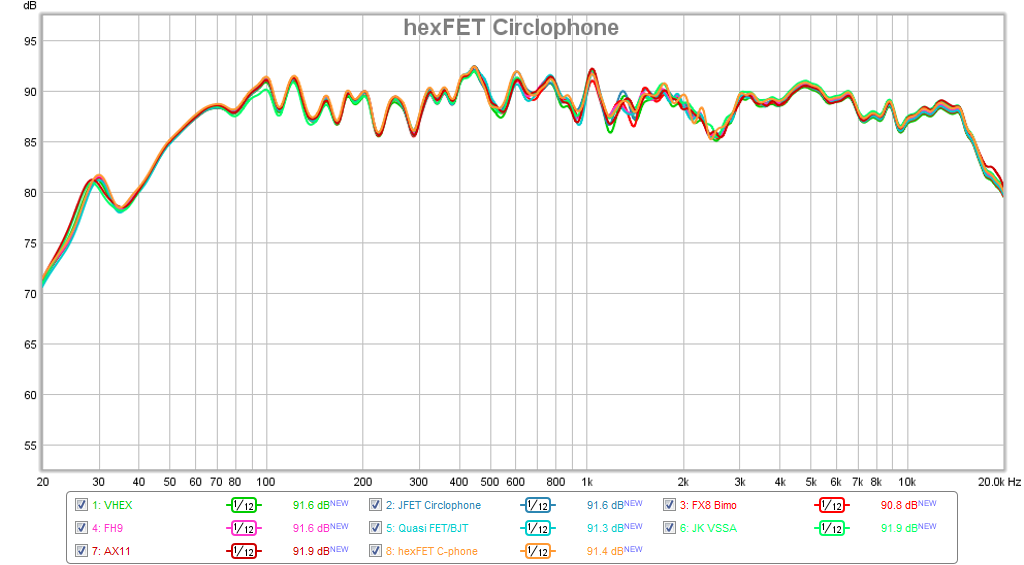
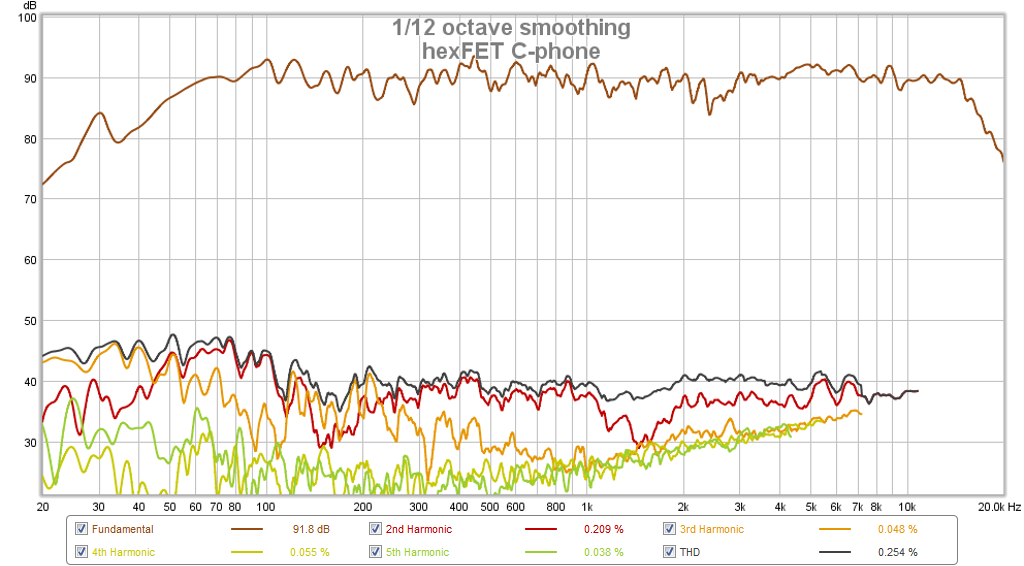
Jay,
Here is an interesting comparison. I only had time for clip 1, but you might get a good idea of differences.


Attachments
Last edited:
The Quasi and Vhex were already connected so not hard to make a clip of each. Confutatis Requiem. Enjoy!
I finally had a chance to listen to my own clips of the complex classical opera with good headphones (Aurvana 3, 2-way balanced armature IEM's with 114dB/mW senstivity), and must say I am quite pleasantly surprised at how well the simple 2-way FAST kept up with the music. But for the added hiss of the recorded clips, they are very close to the original source. Both amps did admirably well I think and it will come down to a preference of dynamics. Here is the kicker, the Vhex amp actually *added* more dynamics to the music IMO. So perhaps some might say that is a bit un-natural sounding, but it's kind of nice in a way - I could actually hear the different instruments and voices better than the source. Strange.
Last edited:
The HexFET sounds pleasant and good to me !
I agree Piersma, the small mods you recommended to convert the original BJT output to a hexFET p-channel output works wonderfully. The distortion is low, the dynamics are great and the sound is very balanced. I called this the FiFo Circlophone (FET in FET out) 🙂
Here is the kicker, the Vhex amp actually *added* more dynamics to the music IMO. So perhaps some might say that is a bit un-natural sounding, but it's kind of nice in a way - I could actually hear the different instruments and voices better than the source. Strange.
Can you provide a link to the Vhex thread?
Is this the amp whose boards use both SM and through-hole devices?
Thanks.
Can you provide a link to the Vhex thread?
Is this the amp whose boards use both SM and through-hole devices?
Thanks.
It's linked in Post #1 - the bold blue VHEX+ link. The boards/kits themselves can be obtained via members jwilhelm or vzaichenko - see their signature line or PM them.
Can you provide a link to the Vhex thread?
Is this the amp whose boards use both SM and through-hole devices?
Thanks.
Ammel, here is the post where VHex+ has been fired-up for the first time:
VHex+ goes live
That's the version, used by X.
See my signature for all the details.
HI!
Thx Xrk for the comparaison between these amps!
And sorry for stupid question:
I don't understand why you don't prefer the FX8 BIMO.
If my understanding is correct, it should be better to have less THD fluctuation which is achieve with the FX8 BIMO curve???
Maybe I am too noob to understand 🙁
Thx Xrk for the comparaison between these amps!
And sorry for stupid question:
I don't understand why you don't prefer the FX8 BIMO.
If my understanding is correct, it should be better to have less THD fluctuation which is achieve with the FX8 BIMO curve???
Maybe I am too noob to understand 🙁
I don't understand why you don't prefer the FX8 BIMO.
If my understanding is correct, it should be better to have less THD fluctuation which is achieve with the FX8 BIMO curve???
Maybe I am too noob to understand 🙁
Everyone has different ears, and (thus) different preference.
But the very important thing is: EVERYONE can easily hear the difference in bass quality, and everyone love bass. The consequence of this is, if you have to design an amplifier for commercial offering, make sure the bass is good, because the amp will win the customers.
Slightly harder to perceive than bass, but still related with bass, is dynamics/sonic. Hexfet tends to excel at these. The cymbal for example, I think was best with FH9.
THD is very difficult to hear once it is low enough like all the amps in this test. When someone prefer an amp in this test, who knows if it is related with THD or not... For example, I can hear that FH9 has higher distortion, but I cannot prove if that is correct or not.
There are other things which are very difficult to hear, but if you can, you might prefer those attributes. Like naturalness, which is a function of amplifier linearity.
ADD: I should add also that sonic is usually the trade-off for THD. So if you want to reduce THD, you may end up with less sonic.
Last edited:
Everyone has different ears, and (thus) different preference.
But the very important thing is: EVERYONE can easily hear the difference in bass quality, and everyone love bass. The consequence of this is, if you have to design an amplifier for commercial offering, make sure the bass is good, because the amp will win the customers.
Slightly harder to perceive than bass, but still related with bass, is dynamics/sonic. Hexfet tends to excel at these. The cymbal for example, I think was best with FH9.
THD is very difficult to hear once it is low enough like all the amps in this test. When someone prefer an amp in this test, who knows if it is related with THD or not... For example, I can hear that FH9 has higher distortion, but I cannot prove if that is correct or not.
There are other things which are very difficult to hear, but if you can, you might prefer those attributes. Like naturalness, which is a function of amplifier linearity.
Hi Jay,
Thx for answer, I understand better....
But maybe I am wrong, on the first graph, FX8 Bimo has better bass to 250hz ????
- Status
- Not open for further replies.
- Home
- Amplifiers
- Solid State
- Virtual Audition of Very Simple Quasi MOSFET Amp
